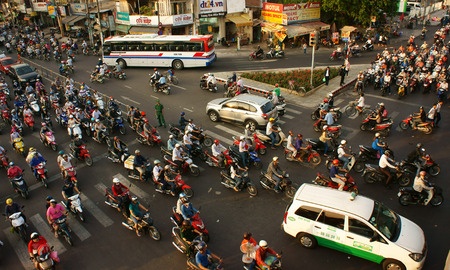10 August, 2017
As Vietnam’s big cities grow, clusters of new buildings sprout up around their peripheries. Rapid urbanisation is transforming cities like Hanoi, and the quiet streets of a few decades ago are today unrecognisable. The question remains – how green is Vietnam’s sprawl?
Buildings account for around 36 per cent of the country’s total energy consumption and 25 per cent of emissions, including a third of carbon dioxide emissions – the main cause of global climate change.
The concept of green construction was introduced for the first time in the country in 2007. Ten years later Vietnam has just 61 constructions with sustainable green certificates. This number is far too modest in a rapidly-developing country where new urban areas are booming. Neighbours like Malaysia, Thailand and Indonesia are doing much better, and Singapore alone boasts more than 2,100 green buildings with a Green Mark certification.
As the country shifts from a rural-agrarian society to an urban-industrial, services-based economy, Vietnam is seeing a significant increase in urbanisation, which stands at approximately 30 per cent today and is expected to increase to 45 per cent by 2020.
First steps
The Government and real estate developers are beginning to take green buildings seriously, with an eye to improving energy efficiency, reducing the toll of urbanisation on the environment and mitigating the effects of climate change.
The Energy Conservation Centre (ECC) was established in 2002 to provide support and consultancy for energy saving in construction. Additionally. the Ministry of Construction promulgated building standards encouraging energy efficiency and the reduction of emissions.
A US-funded programme is providing significant help in implementing an action plan for green growth in the building sector. The programme offers building owners free technical support to provide building energy simulations that can help them achieve substantial energy and green house gas reductions for their newly-designed and retrofitted building demonstration projects.
With expertise drawn from US-based developers, local urban managers will be given training on integrated design and knowledge about energy requirements, helping to incorporate the Vietnam Energy Efficiency Building Code (VEEBC) into the building sector’s action plan for green growth.
Up to 3,000 architects, engineers, project managers, government officials and builders from 40 provinces have already benefited from the programme’s training courses, receiving technical knowledge and skills to effectively enforce and implement the VEEBC. 280 buildings have also been surveyed in order to develop a national database on building energy performance.
The future is green
With new technology, the construction of green buildings is becoming ever easier. Current building practices are getting cheaper and the threat of climate change looms large over policy decisions. In creating greener structures, the benefits of green building can range from environmental to economic to social.
Many developed countries have already taken note of the benefits provided by green buildings and put their own plans into action. Steps like these help countries save energy, protect the environment, and provide a healthier environment for citizens. Green buildings clearly bring significant value to growing cities. They also make good business sense. If planned well, green buildings cause little or no increase in construction costs, and can actually save money in the long run.
Vietnam is among countries suffering the most from climate change, and even in recent years has struggled with rising sea levels, severe droughts and heavy flooding. This prompted the government to prepare a national action plan for green growth from 2014-2020.
However, the government lacks specific policies to encourage green buildings. Support is needed to encourage investment, particularly towards the lower end of the market. Preferential policies on land and credit will help more developers consider green construction, and work to dispel notions that this type of construction is prohibitively expensive. Programmes like the one detailed above attempt to demystify the issue for both the public and professionals within the real estate sector.
Real estate action
The Vietnam Real Estate Association signed a memorandum of understanding with property developers earlier this year, committing them to develop green properties between now and 2022.
The agreement covers three main tasks: completing a legal framework for green buildings, training in green buildings for real estate firms and increasing public awareness on the issue, thus enhancing the popularity of green housing products.
The first developer to support the programme was Capital House, offering a contribution of US$1 million. The company has committed to researching energy-saving solutions and using environmentally-friendly building materials. Three out of its five projects, including some low-priced housing, have been awarded the EDGE green building certification, created for emerging markets by IFC, a member of the World Bank Group.
Other developers such as FLC Group, Viglacera, CEO Group, Alphanam, Phuc Khang and West Lake International Tower Company have also signed up.
It is moves like these that ensure green construction will become a trend in the real estate sector and expand its reach beyond the high-end segment. Better provision of knowledge among firms and the wider public is needed, and this will require more government support and policies that encourage greener growth.
The green buildings market in Vietnam is still in its infancy, primarily as a result of cost sensitivity, low electricity prices, short-term thinking and a limited supply of skilled employees with green building awareness. However, with programmes supporting development within the sector, moves towards market-based electricity pricing, and global corporate guidelines requiring green practices, the market is seeing a belief in green construction begin to take root.
For further information, please contact:
Giles T. Cooper, Partner, Duane Morris
gtcooper@duanemorris.com

.jpg)





